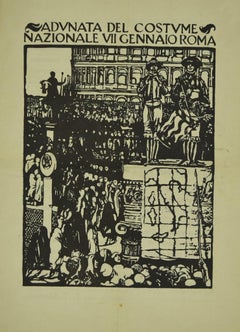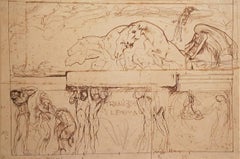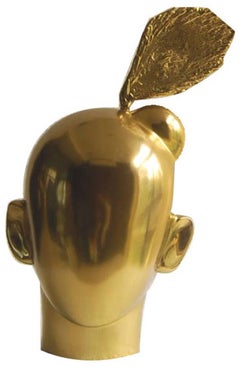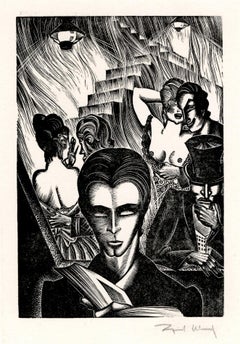Giulio Aristide Sartorio Art
Italian, 1860-1932
Giulio Aristide Sartorio was an Italian painter and film director from Rome. Alongside the activity of landscape artists who saw him, in 1904, he was also among the promoters of the XXV group of the Roman Campagna. He also had numerous public commissions like the famous decorative frieze for the new parliament hall (1908–12), which merges literary inspiration with refined design elegance.
to
4
3
3
1
Overall Height
to
Overall Width
to
3
3
2
1
1
1
1
1
1
1
1
4
1
1
1
4
6,958
3,331
2,514
1,213
1
1
1
1
1
Artist: Giulio Aristide Sartorio
Sibilla - Original Rare book Illustrated by Giulio Aristide Sartorio - 1922
By Giulio Aristide Sartorio
Located in Roma, IT
Sibilla is an original couple of books engraved by Giulio Aristide Sartorio (Rome, 1860 - 1932) in 1922.
Original First Edition.
1333 numbered and signed copies.
Published by L'Eroica, Milan.
Format: in 4°. The dimensions of the book are indicative.
The book includes 230 pages with 219 etchings (70 of them are in full page).
Good conditions.
Giulio Aristide Sartorio (11 February 1860 – 3 October 1932) was an Italian painter and film director from Rome. Having attended the Rome Institute of Fine Arts, Sartorio presented a Symbolist work at the 1883 International Exposition of Rome. He formed friendships with Nino Costa and Gabriele D’Annunzio, and associated with the painters and photographers of the Roman countryside. He won a gold medal at the Paris Universal Exhibition of 1889 and met the Pre-Raphaelites in England in 1893. His participation in the Venice Biennale began in 1895 with the 1st International Exposition of Art of Venice, after which he taught at the Weimar Academy of Fine Arts from 1896 to 1898. His period of greatest renown came at the beginning of the century, when he produced decorative friezes for the 5th Esposizione Internazionale d’Arte of Venice (1903), the Mostra Nazionale of Fine Arts (Milan, Parco Sempione...
Category
1920s Symbolist Giulio Aristide Sartorio Art
Materials
Paper
Gathering of the Costume - Woodcut by G.A. Sartorio -1938
By Giulio Aristide Sartorio
Located in Roma, IT
Gathering of the Costume is a woodcut print realized by Giulio Aristide Sartorio in 1938.
The album composed of 10 pages, was realized for the Royal wedding of King Umberto of Savoy...
Category
1930s Modern Giulio Aristide Sartorio Art
Materials
Woodcut
Sketch for the Parliament Hall “Thanatos and the Enigma” - 1900s - Drawing
By Giulio Aristide Sartorio
Located in Roma, IT
Original drawing, pencil on paper. A wonderful sketch for the frieze for Parliament Hall in Montecitorio Palace, in Rome.
Good conditions except for a diffused foxing, including a w...
Category
Early 1900s Modern Giulio Aristide Sartorio Art
Materials
Ink
Satiro - Original Bronze Sculpture by Giulio Aristide Sartorio
By Giulio Aristide Sartorio
Located in Roma, IT
Bronze head sculpture realized by Giulio Aristide Sartorio, an Italian painter, sculptor and film director from Rome.
Having attended the Rome Institute of Fine Arts, Sartorio presented a Symbolist work at the 1883 International Exposition of Rome. He made friendships with Nino Costa and Gabriele D’Annunzio, and associated with the painters and photographers of the Roman countryside.
His period of greatest renown came at the beginning of the century, when he produced decorative friezes for the 5th Esposizione Internazionale d’Arte of Venice (1903), the Mostra Nazionale of Fine Arts (Milan, Parco Sempione...
Category
Early 20th Century Modern Giulio Aristide Sartorio Art
Materials
Bronze
Related Items
Krishna, Hindu God, Bronze Sculpture, Indian Artist K.S. Radhakrishnan"In Stock"
By K.S. Radhakrishnan
Located in Kolkata, West Bengal
K.S. Radhakrishnan - Krishna - HT : 13 x W : 10 x CIR : 20 inches
Bronze Sculpture.
Krishna : Figurative sculpture of Hindu God by great Modern Indian Artist K.S. Radhakrishnan who has successfully brought about a defenitive resurgence in Indian sculpture.
Style :
K.S Radhakrishnan is one of the most notable among the new generation of sculptors. Like many of his contempories he is a figurative sculptor, but his preference for modelling and bronze casting sets him apart from the rest of them. Recharging age old sculptural processes with a new sensibility, thus is the singular challenge he brings to modern Indian sculpture. And this makes him a modernist - who approaches his work with discernible ambition and considerable aplomb while steering clear of brinkmanship.
Radhakrishnan's works often drawn from the emotions and myths of the Hindu gods, such as Shiva, Kali and Radha. His sculptures are often larger than life-sized; placed in the outdoors, they evoke a superhuman atmosphere. Over the years, Radhakrishnan has experienced with alternate sculpting mediums, working in molten bronze, beeswax and Plaster of Paris.The physical process of working with the materials becomes a performance in itself. The sculpture is the product of a tactile engagement with his medium.
With celebration of sensuality as one of its running themes, his works is at once both intimate and universal in its appeal. A personal commemorative sculpture, with a scale and presence that holds well in natural settings, his work has found permanent home in a number of public collections all over the world.
About the Artist and his work :
Born : Born 1956, Kerala.
Education :
1979 : B.F.A. in Sculpture, Viswa Bharati University, Santiniketan, West Bengal
1981 : M.F.A. in Sculpture, Viswa Bharati University, Santiniketan, West Bengal.
Solo exhibitions :
2006 : ’Freehold’ at Museum Gallery, Mumbai
‘Freehold’ at Artalive Gallery, New Delhi
2005 : ’The Ramp’ at Tao Art Gallery, Mumbai
‘Unbearable Lightness of being’ at India International Centre, New Delhi
2004 : ’The Ramp’ at Sridharani Art Gallery, New Delhi
‘The Ramp’ at Bayer ABS Limited Gallery, Vadodara
2000 : ’Musui Maiya’ sponsored by Vadehra Art Gallery, New Delhi
1998 : ’Song of the Road’ – sponsored by International Travel House, ITC, New Delhi
‘Portal’ – Apeejay Lawns, Calcutta, sponsored by Apeejay Surendra, Group, Calcutta
1993 : Centre des Bonds de Marne, LePerreux-Bry sur-Marne, Paris, France.
1987 : Jehangir Art Gallery, Mumbai.
Participated Exhibitions :
2007 : ’Darpan’ an exhibition sponsored by Nvya Gallery, New Delhi
Travel to Moscow and St. Petersburg, Russia – sponsored by Nvya Gallery.
2006 : Travel to U.S.A, sponsored by Arts India, New York
Travel to Russia, sponsored by Art Resource Trust, Mumbai
Travel to Morocco, sponsored by Popular Prakashan, Mumbai.
2005 : Travel to Istanbul, Turkey to attend artists workshop
Travel to China (Silk Route) sponsored by Uttarayan, Baroda
Travel to South Africa organised by Gallery Navya, New Delhi.
2003 : Travel to Cairo and other cities in Egypt to attend an artists workshop
Travel to France and Italy sponsored by TMI Foundation France
Exhibition titled ‘Can’ curated by Johny M.L
Exhibition ‘Only connect’ at India Habitat Centre, New Delhi
Exhibition ‘Nayika’ by Ganesha Art...
Category
Early 2000s Modern Giulio Aristide Sartorio Art
Materials
Bronze
'Madman's Drum (Plate 41)' — 1930s Graphic Modernism
By Lynd Ward
Located in Myrtle Beach, SC
Lynd Ward, 'Madman's Drum, Plate 41', wood engraving, 1930, edition small. Signed in pencil. A fine, black impression, on off-white tissue-thin Japan paper; the full sheet with margins (1 5/8 to 2 1/2 inches); a small paper blemish in the upper right margin, away from the image, otherwise in excellent condition. Scarce. Matted to museum standards, unframed.
Image size 5 1/2 x 3 3/4 inches (140 x 95 mm); sheet size 9 5/8 x 7 1/8 inches (244 x 181 mm).
From Lynd Ward’s book of illustrations without words, 'Madman’s Drum', Jonathan Cape and Harrison Smith, New York, 1930. Illustrated in 'Storyteller Without Words: The Wood Engravings of Lynd Ward', Harry Abrams, New York, 1974.
Reproduced in 'Storyteller Without Words, the Wood Engravings of Lynd Ward', Harry N. Abrams, New York, 1974.
ABOUT THE ARTIST
Lynd Ward is acknowledged as one of America’s foremost wood engravers and book illustrators of the first half of the twentieth century. His innovative use of narrative printmaking as a stand-alone storytelling vehicle was uniquely successful in reaching a broad audience. The powerful psychological intensity of his work, celebrated for its dynamic design, technical precision, and compelling dramatic content, finds resonance in the literature of Poe, Melville, and Hawthorne. Like these classic American writers, Ward was concerned with the themes of man’s inner struggles and the role of the subconscious in determining his destiny. An artist of social conscience during the Great Depression and World War II, he infused his graphic images with his unique brand of social realism, deftly portraying the problems that challenged the ideals of American society.
The son of a Methodist preacher, Lynd Ward, moved from Chicago to Massachusetts at an early age. He graduated from the Teachers College of Columbia University, New York, in 1926, where he studied illustration and graphic arts. He married May Yonge McNeer in 1936 and left for Europe for their honeymoon in Eastern Europe. After four months, they settled in Leipzig, where Ward studied at the National Academy of Graphic Arts and Bookmaking. Inspired by Belgian expressionist artist Frans Masereel's graphic novel ‘The Sun,’ and another graphic novel by the German artist Otto Nückel, ‘Destiny,’ he determined to create his own "wordless" novel. Upon his return to America, Ward completed his first book, ‘God's Man: A Novel in Woodcuts,’ published in 1929. ‘Gods’ Man’ was a great success for its author and publisher and was reprinted four times in 1930, including a British edition. This book and several which followed it, ‘Madman’s Drum,’ 1930, ‘Wild Pilgrimage...
Category
1930s American Modern Giulio Aristide Sartorio Art
Materials
Woodcut
'Chamonix' Mid-Century Hand Signed Original Lithograph.
By Joan Gardy Artigas
Located in Cotignac, FR
Mid-Century original lithograph entitled " Chamonix " hand signed by Joan Gardy Artigas and numbered 12/75 on arches vellum rag paper from the 1966-70 edition. Presented in period 19...
Category
Mid-20th Century Modern Giulio Aristide Sartorio Art
Materials
Lithograph, Printer's Ink, Rag Paper
H 30.5 in W 14.75 in D 0.5 in
'Simplicius' Farewell to the World' — Graphic Modernism
By Fritz Eichenberg
Located in Myrtle Beach, SC
Fritz Eichenberg, 'Simplicius’ Farewell To The World' from the suite 'The Adventurous Simplicissimus', wood engraving, 1977, artist's proof apart from the edition of 50. Signed in pencil. Signed in the block, lower right. A fine, richly-inked impression, on cream wove paper, with full margins (1 1/2 to 2 inches), in excellent condition. Image size 14 x 12 inches (356 x 305 mm); sheet size 17 1/2 x 15 inches (445 x 381 mm). Archivally sleeved, unmatted.
ABOUT THIS WORK
'Simplicius Simplicissimus' (German: Der abenteuerliche Simplicissimus Teutsch) is a picaresque novel of the lower Baroque style, written in five books by Hans Jakob Christoffel von Grimmelshausen published in 1668, with the sequel Continuatio appearing in 1669.
The novel is told from the perspective of its protagonist Simplicius, a rogue or picaro typical of the picaresque novel, as he traverses the tumultuous world of the Holy Roman Empire during the Thirty Years' War. Raised by a peasant family, he is separated from his home by foraging dragoons. He is adopted by a hermit living in the forest, who teaches him to read and introduces him to religion. The hermit also gives Simplicius his name because he is so simple that he does not know his own name. After the death of the hermit, Simplicius must fend for himself. He is conscripted at a young age into service and, from there, embarks on years of foraging, military triumph, wealth, prostitution, disease, bourgeois domestic life, and travels to Russia, France, and an alternate world inhabited by mermen. The novel ends with Simplicius turning to a life of hermitage, denouncing the world as corrupt.
ABOUT THE ARTIST
Fritz Eichenberg (1901–1990) was a German-American illustrator and arts educator who worked primarily in wood engraving. His best-known works were concerned with religion, social justice, and nonviolence.
Eichenberg was born to a Jewish family in Cologne, Germany, where the destruction of World War I helped to shape his anti-war sentiments. He worked as a printer's apprentice and studied at the Municipal School of Applied Arts in Cologne and the Academy of Graphic Arts in Leipzig, where he studied under Hugo Steiner-Prag. In 1923 he moved to Berlin to begin his career as an artist, producing illustrations for books and newspapers. In his newspaper and magazine work, Eichenberg was politically outspoken and sometimes wrote and illustrated his reporting.
In 1933, the rise of Adolf Hitler drove Eichenberg, who was a public critic of the Nazis, to emigrate with his wife and children to the United States. He settled in New York City, where he lived most of his life. He worked in the WPA Federal Arts Project and was a member of the Society of American Graphic Artists.
In his prolific career as a book illustrator, Eichenberg portrayed many forms of literature but specialized in works with elements of extreme spiritual and emotional conflict, fantasy, or social satire. Over his long career, Eichenberg was commissioned to illustrate more than 100 classics by publishers in the United States and abroad, including works by renowned authors Dostoyevsky, Tolstoy, Charlotte and Emily Brontë, Poe, Swift, and Grimmelshausen. He also wrote and illustrated books of folklore and children's stories.
Eichenberg was a long-time contributor to the progressive magazine The Nation, his illustrations appearing between 1930 and 1980. Eichenberg’s work has been featured by such esteemed publishers as The Heritage Club, Random House, Book of the Month Club, The Limited Editions Club, Kingsport Press, Aquarius Press, and Doubleday.
Raised in a non-religious family, Eichenberg had been attracted to Taoism as a child. Following his wife's unexpected death in 1937, he turned briefly to Zen Buddhist meditation, then joined the Religious Society of Friends in 1940. Though he remained a Quaker until his death, Eichenberg was also associated with Catholic charity work through his friendship with Dorothy Day...
Category
1970s American Modern Giulio Aristide Sartorio Art
Materials
Woodcut
'The Pimp' — Graphic Modernism
By Fritz Eichenberg
Located in Myrtle Beach, SC
Fritz Eichenberg, 'The Pimp', wood engraving, 1980, artist's proof before the edition. Signed in pencil. Signed in the block, lower right. A fine, richly-inked impression, on cream wove paper, with full margins (2 3/16 to 3 1/2 inches), in excellent condition. Archivally sleeved, unmatted.
Image size 12 x 9 3/4 inches (305 x 248 mm); sheet size 18 x 14 inches (457 x 356 mm).
ABOUT THE ARTIST
Fritz Eichenberg (1901–1990) was a German-American illustrator and arts educator who worked primarily in wood engraving. His best-known works were concerned with religion, social justice, and nonviolence.
Eichenberg was born to a Jewish family in Cologne, Germany, where the destruction of World War I helped to shape his anti-war sentiments. He worked as a printer's apprentice and studied at the Municipal School of Applied Arts in Cologne and the Academy of Graphic Arts in Leipzig, where he studied under Hugo Steiner-Prag. In 1923 he moved to Berlin to begin his career as an artist, producing illustrations for books and newspapers. In his newspaper and magazine work, Eichenberg was politically outspoken and sometimes wrote and illustrated his reporting.
In 1933, the rise of Adolf Hitler drove Eichenberg, who was a public critic of the Nazis, to emigrate with his wife and children to the United States. He settled in New York City, where he lived most of his life. He worked in the WPA Federal Arts Project and was a member of the Society of American Graphic Artists.
In his prolific career as a book illustrator, Eichenberg portrayed many forms of literature but specialized in works with elements of extreme spiritual and emotional conflict, fantasy, or social satire. Over his long career, Eichenberg was commissioned to illustrate more than 100 classics by publishers in the United States and abroad, including works by renowned authors Dostoyevsky, Tolstoy, Charlotte and Emily Brontë, Poe, Swift, and Grimmelshausen. He also wrote and illustrated books of folklore and children's stories.
Eichenberg was a long-time contributor to the progressive magazine The Nation, his illustrations appearing between 1930 and 1980. Eichenberg’s work has been featured by such esteemed publishers as The Heritage Club, Random House, Book of the Month Club, The Limited Editions Club, Kingsport Press, Aquarius Press, and Doubleday.
Raised in a non-religious family, Eichenberg had been attracted to Taoism as a child. Following his wife's unexpected death in 1937, he turned briefly to Zen Buddhist meditation, then joined the Religious Society of Friends in 1940. Though he remained a Quaker until his death, Eichenberg was also associated with Catholic charity work through his friendship with Dorothy Day...
Category
1980s American Modern Giulio Aristide Sartorio Art
Materials
Woodcut
Irving Amen, The Heart is a Garden, Signed A/P & Framed Woodblock Print
By Irving Amen
Located in Plainview, NY
A woodblock print in color, of a girl looking up at a giant flower bouquet by Irving Amen ( American, 1918-2011) . The lithograph entitled "The Heart is a Garden " is signed Amen and...
Category
20th Century Modern Giulio Aristide Sartorio Art
Materials
Woodcut
H 34 in W 25 in D 1.5 in
Wedding Party
Located in Buffalo, NY
An original mid century modern woodblock print.
This work is hand signed illegibly and titled "Wedding Party".
Category
1960s Modern Giulio Aristide Sartorio Art
Materials
Paper, Woodcut
Woodblock Portrait of a Woman
Located in Soquel, CA
Bold woodblock print of a woman by J. Duffy (American, 20th Century). The subject is staring directly at the viewer, creating a compelling yet delicate composition. The ink appears t...
Category
1950s Modern Giulio Aristide Sartorio Art
Materials
Ink, Woodcut, Paper
Modern American Industrial Landscape
Located in Buffalo, NY
An original woodblock print dated 1965, titled "Our Town" but signed illegibly.
Category
1960s American Modern Giulio Aristide Sartorio Art
Materials
Woodcut, Paper
"Schooner + Doryman" First Edition Hand-Colored Woodblock Print
By Byron Randall
Located in Soquel, CA
Bold woodblock print by Byron Randall (American, 1918-1999). Titled "Schooner + Doryman", numbered "1st ed.", and signed and dated "Byron Randall '62" along the bottom edge. Small am...
Category
1960s American Modern Giulio Aristide Sartorio Art
Materials
Gold Leaf
H 22 in W 28 in D 0.25 in
"Nara" Japanese Townscape
By Kiyoshi Saitō
Located in Houston, TX
Landscape print of small Japanese city, Nara (A). Signature and seal lower right. Mat board covers the margins which may have date, title and edition. Non-glare glass makes inspection and photography difficult. Visible Area: H 15 in. x W 20.5 in.
Artist Biography:
Kiyoshi Saito was born in Fukushima prefecture in 1907. At the age of five he moved to Otaru in Hokkaido, where he would come to serve as an apprentice to a sign painter. Saito became infatuated with art after studying drawing with Gyokusen Narita and moved to Tokyo in 1932 to study Western-style painting at the Hongo Painting Institute. He began experimenting with woodblock prints and exhibiting his works with Nihon Hanga Kyokai in 1936. Saito mainly worked in oil painting until his invitation from Tadashige Ono...
Category
20th Century Modern Giulio Aristide Sartorio Art
Materials
Woodcut
"Woman" Nude Figurative Etching
Located in Soquel, CA
Elegant nude by Suzanne Aubin Ledrew (American, b. 1942). The woman in this piece is seated, with her hand covering her face and head, turned partially away from the viewer. There is a lovely contract between the background and the figure, creating a negative shape out of the woman's body.
Titled "WOMAN" in the lower center.
Signed and dated "AUBIN LEDREW 74" in the lower right corner.
Presented in a new grey mat with a wood frame.
Image size: 12"H x 9"W
Suzanne Addicott (nee Aubin Ledrew) (American, b. 1942) graduated from California College of the Arts with a BFA in Painting and Drawing. She is an artist and teacher at Studio9...
Category
1970s Modern Giulio Aristide Sartorio Art
Materials
Ink, Paper
Giulio Aristide Sartorio art for sale on 1stDibs.
Find a wide variety of authentic Giulio Aristide Sartorio available for sale on 1stDibs. You can also browse by medium to find art by Giulio Aristide Sartorio in bronze, ink, metal and more. Much of the original work by this artist or collective was created during the 20th century and is mostly associated with the modern style. Not every interior allows for large Giulio Aristide Sartorio, so small editions measuring 6 inches across are available. Customers who are interested in this artist might also find the work of Antonio Donghi, Yasuo Kuniyoshi, and Giovanni Pintori. Giulio Aristide Sartorio prices can differ depending upon medium, time period and other attributes. On 1stDibs, the price for these items starts at $1,393 and tops out at $27,851, while the average work can sell for $5,093.





